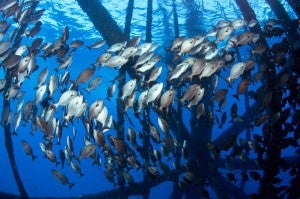As I’ve written before, the Rigs to Reefs permitting process of the federal and state agencies in the Gulf of Mexico is a good example of “finding ways that work.” This cooperative process enables the owners of oil and gas platforms to use those structures to support artificial reefs. In fact, this means the rigs continue serving as artificial reefs because they have already attracted fish, coral, and other marine life as the rigs produced oil or gas.
Over the past few years, the issue of rig removal has become a heated topic among anglers as the federal government undertook more aggressive measures to remove retired rigs. The officials responsible for safe retirement of end-of-service rigs and the anglers and divers who benefit from the marine life around those rigs have been at odds over the best ways to maintain reef habitats while also providing for other uses of the Gulf. That tension was reduced this week when the Bureau of Safety and Environmental Enforcement, a division of the Department of Interior, issued a new policy addressing several sticking points that arose in recent years. Most of the log jam has been caused by basic questions of process: how many rigs would remain as reef habitat, where would they be placed, and how would they be secured?
The pressure built as the number of rigs reaching the end of their productive life and the end of their leases began to rise. Starting in 2005, the number of applications for removals spiked, and Hurricane Katrina damaged even more platforms and disrupted existing artificial reefs. These pressures complicated the challenge for the Department of Interior to assure safe disposition of an increasing number of platforms.
In 2010 – after the Deepwater Horizon disaster – the department issued a notice to lease-holders that it was modifying procedures to ensure faster removals in the interest of safety. Anglers and divers began to see more rigs being removed, and many were removed using explosives that would leave hundreds of dead fish floating in the wake of the project.
The clamor, however, also involved effective coordination among all concerned. The Bureau of Safety and Environmental Enforcement, working with the White House National Ocean Council, the other cabinet agencies, scientists, and stakeholders, developed changes to policy that will ease the process. Sportsmen groups such as the Congressional Sportsmen’s Foundation played a leading role. EDF, after stepping forward as an early supporter of revising the 2010 policy, encouraged and supplied data to these discussions. We are proud to say that we were the only major ENGO to speak out for the interests of anglers in this debate.
The most important features of the new policy are that it drops the requirement for distance between reef sites, adds an allowance for creating a reef where a rig currently stands, and extends deadlines for removal for platform owners seeking approval for a reefing project.
This improved approach is a step in the right direction, and we are hopeful that it will lead to better fish habitat, populations, and recreational opportunities. It is especially welcome as reef-fish issues and red snapper management in particular are hot topics in the Gulf right now.
Congratulations are due to all those who are dedicated to finding ways that work.










